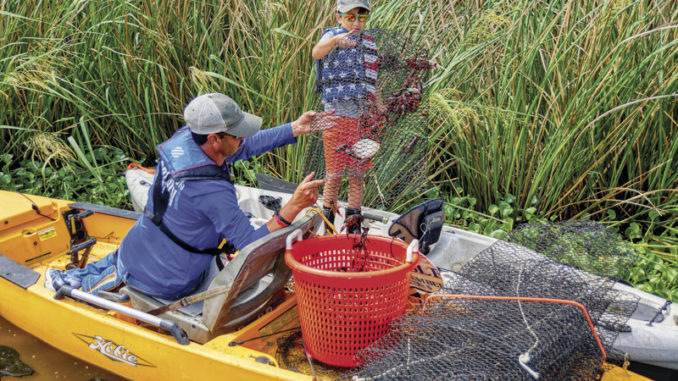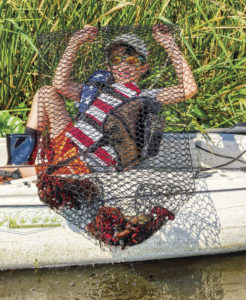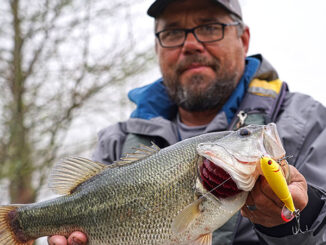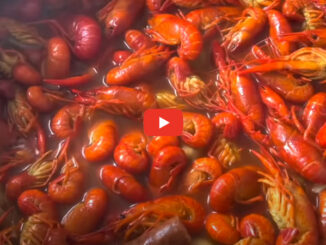
Paddle your way to a very tasty crawfish boil.
These are crazy, sad times for sure. First and foremost, everyone should be adhering to the recommended safety guidelines, and hopefully, we will all come out of this coronavirus mess and bounce back stronger than ever.
Fortunately, Louisiana citizens are not being overly restricted or even prevented when it comes to hunting and fishing activities. It is good to be outside, both mentally and physically. Kayaks are perfectly suited for these restricted times. Most are single-seat models, and even if a small group ventures out together, it is easy to maintain social-distancing recommendations.
Fishing is the most-popular use of kayaks in Louisiana, and it’s great to enjoy the outdoors with family and friends. Children particularly like the sense of responsibility and accomplishment of handling a kayak on their own — if they are old enough to safely handle one. While fishing is a great activity, sometimes a lack of experience or simply a bad fishing day can become boring and lose their attention. However, other activities like crabbing or crawfishing from a kayak can be relatively inexpensive and productive.
I recently accompanied James Kellum and his 10-year-old son, Kaleb, on a crawfishing adventure in their kayaks. While Kaleb has ridden shotgun on his father’s kayak for several fishing adventures, this was only his second trip as captain of his own kayak.
Crawfish
We are in the peak of crawfishing season across Louisiana, and while the vast majority of public consumption comes from commercially purchased mudbugs, many kids my age grew up chasing them in ponds, swamps and neighborhood ditches everywhere. Whether scooping with a net, pulling in with a string line or using pyramid nets, it was an easy and exciting — albeit muddy — adventure.

Those techniques still work, but the use of traps can increase the catch and substantially decrease the work. The most-common and least-expensive is the coated-wire pillow trap. These are easy to bait and set and can be flattened for storage and transport. They are lightweight and can be stacked for easy carry on the kayak.
Crawfish are known to bite better at night, so putting traps out late in the evening and returning for pickup the next morning is a good strategy.
Baits to use
Crawfish are not that picky and can be lured with a variety of baits. However, fresh baitfish such as shad or pogie are generally the best. Beef melts, available at many local meat markets, work well, but they are better suited for use with nets since they tend to wash out when soaked for long periods in a trap.
Pillow traps are set with a string and small cork to mark their location. They can be set in any water depth, but they should be fully submerged, and their use in depths up to about 6 feet seems to be best. This method is truly a set-it-and-forget-it activity, with no need to check the traps once deployed.
Some folks like to combine the use of traps and nets for a crawfishing outing. While the traps are passively doing their thing, running a line of nets is a fun activity that helps pass the waiting time.
If the area you are fishing has a relatively flat bottom and shallow water, the use of simple pyramid nets can easily be accomplished from the kayak or you can simply get out and walk. A long pole is used to set and retrieve the nets. They are typically set with the peak of the wire frame sticking above the water with a bright ribbon tied on to mark their location. After being set, the nets are run after a 15- to 20-minute soak time. You have to be quick on the pick-up since the nets have no sides and crawfish can go over the edges if not quickly dumped in the basket.
Nets
Nets can also be used in water too deep for pyramid nets. Deepwater crawfish nets are similar to traditional crab nets but have a smaller mesh size to keep the mudbugs from slipping through. Also set with a cork and string, it is easy to quietly kayak right next to the cork and pull the line in for retrieval.
There’s always suspense when pulling up a net or trap. Will it be a dud or filled with tasty critters? For our trip, his father allowed Kaleb to pull up all the traps and nets while he stayed nearby to assist with dumping the bounty into the basket. Each trap and net was eagerly pulled, with many laughs and squeals along the way. The good thing about traps is that there is no danger of any crawfish escaping if the child pulls slowly or the trap drops from their hands. It is just a simple matter of pulling it back in.
Then it took only about 90 minutes to pick up and empty the 10 traps that had been set the night before. It was a fun and simple task, hampered only somewhat by strong winds that gave Kaleb a bit of trouble maneuvering the kayak. All traps had crawfish, while some had a bit more than others. A couple of deepwater nets were set on the way out and picked up three times during the span of picking up the traps. An estimated 25 pounds of decent crawfish were caught and made for a delicious family boil.
Louisiana recreational crawfish regulations
No fishing or gear license is required to use crawfish nets, dip nets, hand lines or bait seines. However, a basic Recreational Fishing license or Wild Louisiana Stamp is required for their use on Louisiana Department of Wildlife and Fisheries WMAs or refuges. Crawfish traps may be prohibited on certain WMAs and refuges. Check regulations for details.
Crawfish traps must be marked with a waterproof tag, with the name and recreational gear license number of the fisherman legibly printed on the tag. No more than 35 traps per person can be used recreationally.
There is no minimum size for crawfish; the daily bag and possession limit is 150 pounds per person in state waters. A resident trap license is $15.00 for up to 35 traps, and a basic Recreational Fishing License is $9.50.
For full regulations go to: www.lwf.louisiana.gov


